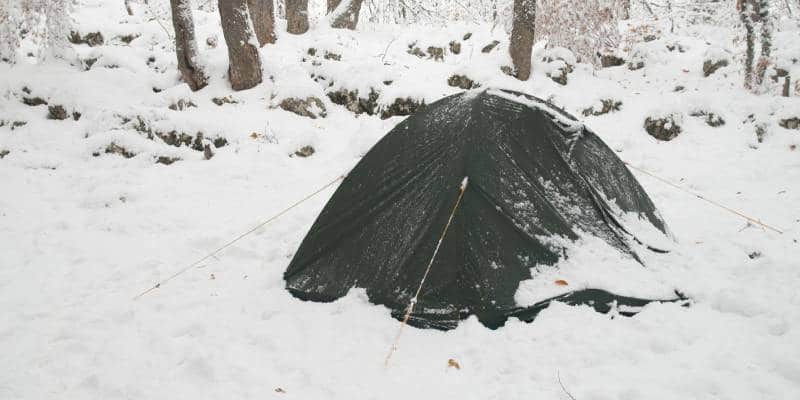There is just this different kind of rush when you’re camping in winter. Most people prefer to spend the season cooped inside their homes while sipping a cup of hot chocolate. It seems that you’re not most people, and your adventurous bone is irking to go outside. We won’t stop you, but before you go, you’ve got to make sure that you’re prepared for what you might face outside.
Being caught in a snowstorm can be terrifying. High winds, freezing temperatures, and disorientation are all problems to deal with. In this article, we’ll discuss some general strategies you can use to help deal with a blizzard or snowstorm.
You may like to read: Tips for Camping with Agoraphobia
Preparedness
One of the most critical steps to take is to be prepared. An integral part of camping is being prepared for all types of weather—warm, windy, rainy, and yes, even snow. Knowing where you are camping and the weather forecast for the area can help you plan ahead. Make sure that you know the weather predictions and have a plan for the eventuality you are caught in a snowstorm.
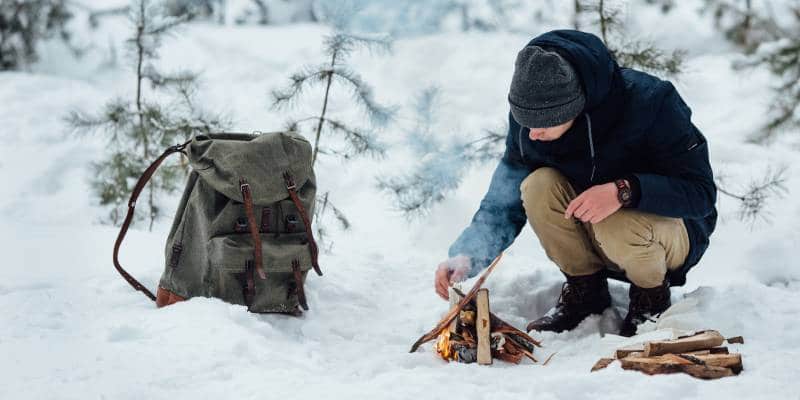
If possible, use satellite weather maps to track the snow systems. Knowing the weather ahead of time can give you the precious time you need to take the necessary steps. Prepare a spare set of clothes, dry material for starting a fire, and extra rations for emergency calories.
Take all the time you need to prepare for every calamity. Trust us; you do not want to be mending a shelter during a blizzard or snowstorm at 3 am.
Shelter
High winds and blinding snow can be a serious issue when camping. It’s important to choose a location and shelter accommodations that mitigate wind as best as you can. Planning is essential here; using trees or whatever coverage is available can help. You can use existing snowfall and dig out a small enclave. Tree branches, especially pine tree ones, can be beneficial when creating an insulating shelter.
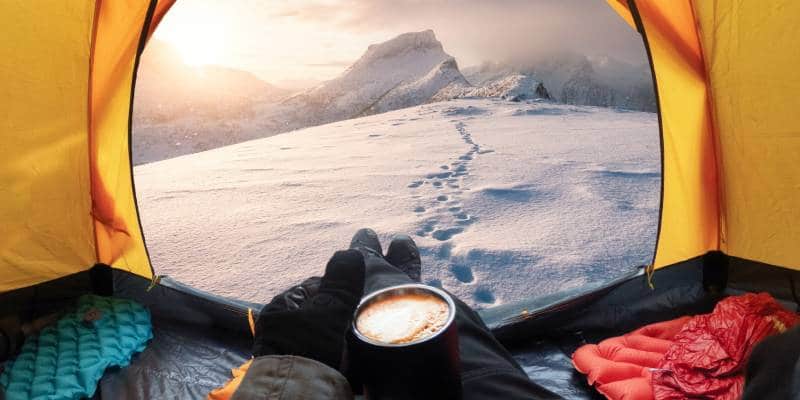
If you’re bringing a tent to your campsite, make sure that it’s sturdy enough to withstand heavy winds and intense blizzards. If your budget permits, you might want to invest in a four-season tent. These types of tents are made for camping at any time of the year. It may be a little on the expensive side, but it’s worth splurging your money on.
Whatever shelter you’re in, too much-collected snow overhead may cause the tent to collapse. Be mindful of your temporary shelter as it provides you a protective layer from the harsh winds.
Knowing which way the wind is coming can help immensely. If you have a fire, make sure you shelter it as best you can. Use whatever materials you can to cover and create a barrier for it. Be mindful of air pockets and air barriers. Try and elevate your shelter above ground level and seal it appropriately from heat loss.
Warmth and Wetness
It’s imperative to stay dry and warm as best you can during a snowstorm. Having proper clothes for the conditions is crucial. Wet clothes can lead to frostbite and/or hypothermia. As mentioned earlier, have a backup set of clothes, especially socks and gloves. Keeping your reserves warm and dry is extremely important when caught in a snowstorm.
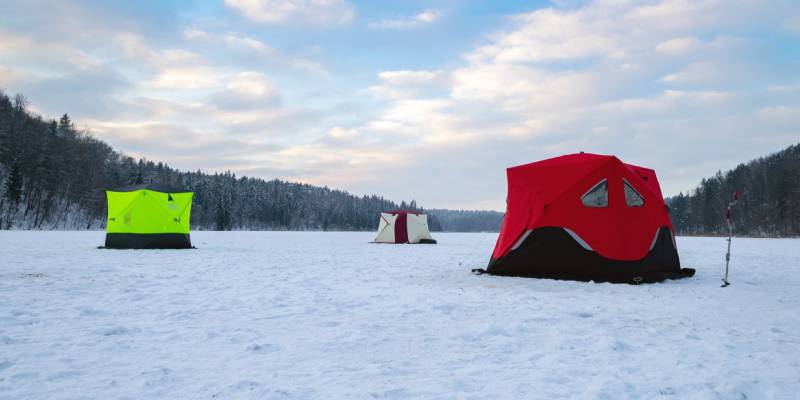
Make sure your shelter has layers of insulation as well as your clothes. Tarps, water-resistant clothing, and the material will help keep you dry. The more time you give yourself to prepare, the better off you will be.
If the winds are steady, spend your time preparing for another snowstorm. Calorie management is crucial here; your body burns lots of calories in response to the cold to keep you warm, so it’s essential to budget your energy and time accordingly. Keep safe, dry, and warm.
Best Clothing for Camping in Winter
It’s a general camping rule that you’d have to prepare clothing for any kind of weather. This time around, however, you’d need to tweak your camping couture to make it more appropriate for the winter weather.

First off—shoes.
If you’re adamant about camping during the winter, you might want to invest in a good pair of winter hiking boots. The ones you own are fine too, as long as it’s waterproof and has soles that will prevent you from slipping on the snow.
Layers are ideal for camping.
If you get cold, you can always add a shirt or a jacket. If you get warm, you can quickly shed some articles of clothing. It’s a little different in the winter, though. The general rule here is to wear three different layers—the base, middle, and outer layer.
Choose a light, zipped-up shirt for the base layer, then a sweater made of thicker material for the middle layer. Ensure that the fabric used in these layers can insulate heat. Lastly, the outer layer—this is the most essential layer, so pay attention to what you wear. Padded and waterproof pants and jackets are ideal outer layers.
If possible, avoid tops made from cotton.
Cotton fabrics can absorb melted snow, leaving you freezing in the cold. You might want to prepare clothes made from synthetic and wool materials.
Gloves, hats, and other accessories must also be a part of your camping bag.
Gloves and headwear retain the heat in your body and helps keep you warm for a more extended period. Sunglasses are also an essential part of your camping gear. The snow reflects UV rays far easier, and more intensely than other terrains, so you’ll have to protect your eyes as well!
Other Tips For Camping During a Snowstorm
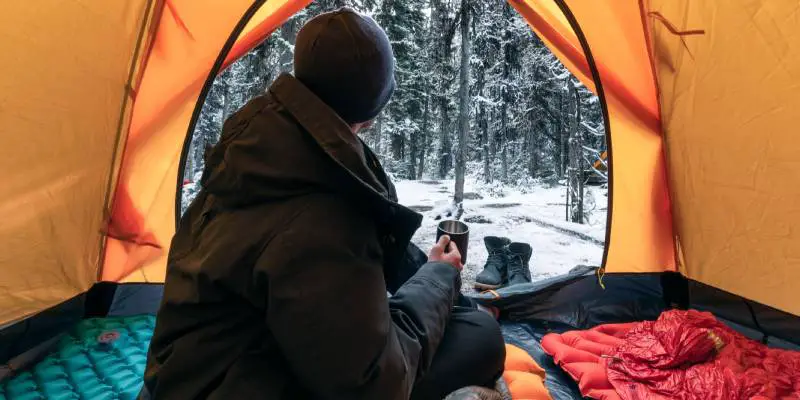
Stay calm.
Being caught in a snowstorm is frightening, and it may trigger unwanted reactions, which may make the situation worse than it already is. In times of disaster, one must try their best to stay calm. Staying calm offers you the mindset you’d need to think clearly and more productively.
Before leaving, assign an emergency contact.
Some might think that appointing an emergency contact is like predicting that something unfortunate would occur, but it’s an integral part of the planning phase before camping. For areas without a cellphone signal, a satellite phone may be helpful.
In Conclusion…
The best way to handle a snowstorm while camping is to be prepared for it. Remember to keep as dry as possible and be mindful of air barriers and air pockets. Bring an extra set of clothes, gloves, and socks. Keep safe, warm, and dry.
